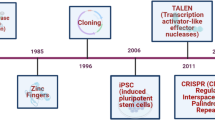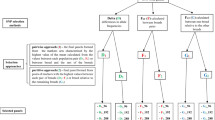Abstract
The STAT5A gene was studied as a candidate gene for five milk production traits (milk yield at 305 days, protein percentage, fat percentage, lactose percentage and dry matter percentage) in Holstein cows. According to the sequence of bovine STAT5A gene, two pairs of primers (P1 and P2) were designed to detect polymorphisms of STAT5A gene in 401 Holstein cows by PCR-RFLP and PCR-SSCP. The results showed that the products amplified by primers P1 and P2 displayed polymorphisms. For P1, three genotypes (AA, AG, and GG) were detected, and the frequency of AA/AG/GG was 0.252/0.486/0.262, respectively. Sequence analysis revealed a single nucleotide substitution A–G at 14217 bp (GenBank NC_007317) of bovine STAT5A gene while compared GG genotype with AA genotype. The differences of the least squares means for the four milk production traits (milk yield at 305 days, fat percentage, lactose percentage and dry matter percentage) between AA, AG and GG were not significant (P > 0.05). Least squares mean of protein percentage for AG or GG was significantly higher than that for AA (P < 0.05); the difference of the least squares mean for protein percentage was not significant between AG and GG (P > 0.05). For P2, three genotypes (CC, CT, and TT) were detected in Holstein cows, and the frequency of CC/CT/TT was 0.751/0.234/0.015, respectively. Sequencing revealed an insertion CCT at 17266 (NC_007317) of bovine STAT5A gene while compared CC genotype with TT genotype. The differences of the least squares means for the three milk production traits (protein percentage, lactose percentage and dry matter percentage) between CC, CT and TT were not significant (P > 0.05). Least squares mean of milk yield at 305 days for TT or CT was significantly higher than that for CC (P < 0.05); the difference of the least squares mean for milk yield at 305 days was not significant between TT and CT (P > 0.05). Least squares mean of fat percentage for CC or CT was significantly higher than that for TT (P < 0.05); the difference of the least squares mean for fat percentage was not significant between CC and CT (P > 0.05). The results preliminarily indicated that allele G of A14217G polymorphic site of STAT5A gene is a potential DNA marker for improving protein percentage in dairy cattle, 17266indelCCT polymorphic site of STAT5A gene is a potential DNA marker for improving milk yield at 305 days and fat percentage in dairy cattle.





Similar content being viewed by others
References
Liu X, Robinson GW, Goiouilleux F, Groner B, Hennighausen L (1995) Cloning and expression of STAT5 and an additional homologue (STAT5B) involved in prolactin signal transduction in mouse mammary tissue. Proc Natl Acad Sci USA 92(19):8831–8835
Darnell JE Jr (1997) STATs and gene regulation. Science 277(5332):1630–1635
Liu X, Robinson GW, Hennighausen L (1996) Activation of STAT5 and STAT5B by tyrosine phosphorylation is tightly linked to mammary gland differentiation. Mol Endocrinol 10(12):1496–1506
Liu X, Robinson GW, Wagner KU, Garrett L, Wynshaw-Boris A, Hennighausen L (1997) STAT5A is mandatory for adult mammary gland development and lactogenesis. Genes Dev 11(2):179–186
Udy GB, Towers RP, Snell RG, Wilkins RJ, Park SH, Ram PA, Waxman DJ, Davey HW (1997) Requirement of STAT5B for sexual dimorphism of body growth rates and liver gene expression. Proc Natl Acad Sci USA 94(14):7239–7244
Bole-Feysot C, Goffin V, Edery M, Binart N, Kelly PA (1998) Prolactin (PRL) and its receptor: actions, signal transduction pathways and phenotypes observed in PRL receptor knockout mice. Endocr Rev 19(3):225–268
Wang H, Han YP, Liu ZL (2000) Research advances of STATs. Foreign Med Sci Sect Pathophysiol Clin Med 20(5):354–357
Rowland JE, Lichanska AM, Kerr LM, White M, d’Aniello EM, Maher SL, Brown R, Teasdale RD, Noakes PG, Waters MJ (2005) In vivo analysis of growth hormone receptor signaling domains and their associated transcripts. Mol Cell Biol 25(1):66–77
Grebien F, Kerenyi MA, Kovacic B, Kolbe T, Becker V, Dolznig H, Pfeffer K, Klingmüller U, Müller M, Beug H, Müllner EW, Moriggl R (2008) STAT5 activation enables erythropoiesis in the absence of EpoR and Jak2. Blood 111(9):4511–4522
Lewis RS, Ward AC (2008) STAT5 as a diagnostic marker for leukemia. Expert Rev Mol Diagn 8(1):73–82
Santos SJ, Haslam SZ, Conrad SE (2008) Estrogen and progesterone are critical regulators of STAT5A expression in the mouse mammary gland. Endocrinology 149(1):329–338
Byts N, Samoylenko A, Fasshauer T, Ivanisevic M, Hennighausen L, Ehrenreich H, Sirén AL (2008) Essential role for STAT5 in the neurotrophic but not in the neuroprotective effect of erythropoietin. Cell Death Differ 15(4):783–792
Molenaar A, Wheeler TT, McCracken JY, Seyfert HM (2000) The STAT3-encoding gene resides within the 40 kbp gap between the STAT5A- and STAT5B-encoding genes in cattle. Anim Genet 31(5):339–340
Seyfert HM, Pitra C, Meyer L, Brunner RM, Wheeler TT, Molenaar A, McCracken JY, Herrmann J, Thiesen HJ, Schwerin M (2000) Molecular characterization of STAT5A- and STAT5B-encoding genes reveals extended intragenic sequence homogeneity in cattle and mouse and different degrees of divergent evolution of various domains. J Mol Evol 50(6):550–561
Brym P, Kamiński S, Ruść A (2004) New SSCP polymorphism within bovine STAT5A gene and its associations with milk performance traits in Black-and-White and Jersey cattle. J Appl Genet 45(4):445–452
He F, Sun Dong-xiao, Yu Ying, Wang Ya-chun, Zhang Yuan (2007) SNPs detection of STAT5A gene and association with milk production traits in Holstein cattle. Acta Veterinaria et Zootechnica Sinica 38(4):326–331
Antoniou E, Hirst BJ, Grosz M, Skidmore CJ (1999) A single strand conformational polymorphism in the bovine gene STAT5A. Anim Genet 30(3):232
Flisikowski K, Szymanowska M, Zwierzchowski L (2003) The DNA-binding capacity of genetic variants of the bovine STAT5A transcription factor. Cell Mol Biol Lett 8(3):831–840
Khatib H, Monson RL, Schutzkus V, Kohl DM, Rosa GJ, Rutledge JJ (2008) Mutations in the STAT5A gene are associated with embryonic survival and milk composition in cattle. J Dairy Sci 91(2):784–793
Bao B, Fang XT, Chen H, Zhang RF, Yan LJ, Zhang HJ (2008) Polymorphisms of STAT5A gene and its association with milk performance traits in Chinese Holstein cattle. Scientia Agricultura Sinica 41(6):1872–1878
Selvaggi M, Dario C, Normanno G, Celano GV, Dario M (2009) Genetic polymorphism of STAT5A protein: relationships with production traits and milk composition in Italian Brown cattle. J Dairy Res 29:1–5
Mao J, Molenaar AJ, Wheeler TT, Seyfert HM (2002) STAT5 binding contributes to lactational stimulation of promoter III expressing the bovine acetyl-CoA carboxylase alpha-encoding gene in the mammary gland. J Mol Endocrinol 29(1):73–88
Acknowledgments
This research was supported by National Key Technology Research and Development Program of China (No. 2006BAD04A10) and Beijing Natural Science Foundation of China (No. 6022015).
Author information
Authors and Affiliations
Corresponding author
Rights and permissions
About this article
Cite this article
He, X., Chu, M.X., Qiao, L. et al. Polymorphisms of STAT5A gene and their association with milk production traits in Holstein cows. Mol Biol Rep 39, 2901–2907 (2012). https://doi.org/10.1007/s11033-011-1051-4
Received:
Accepted:
Published:
Issue Date:
DOI: https://doi.org/10.1007/s11033-011-1051-4




